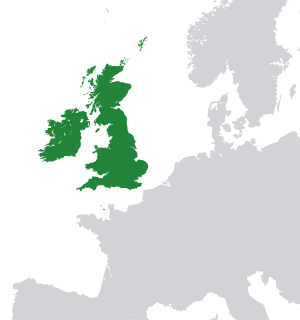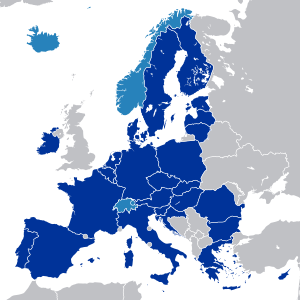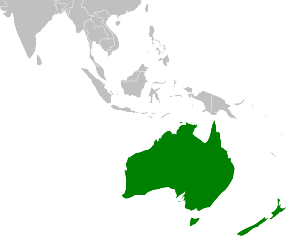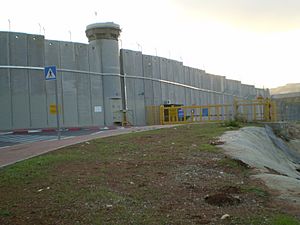Freedom of movement facts for kids
Freedom of movement, also called mobility rights or the right to travel, is a basic human rights idea. It means people can travel from one place to another within their own country. It also means they can leave their country and come back to it. This right includes not just visiting places, but also choosing where to live or work.
Many country constitutions and international law documents include this right. For example, Article 13 of the Universal Declaration of Human Rights says:
- "Everyone has the right to freedom of movement and residence within the borders of each state."
- "Everyone has the right to leave any country, including his own, and to return to his country."
Some people believe freedom of movement should also mean being able to move freely between different countries. Governments can limit this right in different ways. These limits are usually for public health, safety, or to keep things orderly.
Contents
Why is Freedom of Movement Important?
Freedom of movement is a key part of personal liberty. It allows people to seek new opportunities. This could be for jobs, education, or to live closer to family. It also helps people escape difficult situations.
How Can Movement Be Limited?
Governments often limit international travel, like when people enter or leave a country. Within a country, movement can be limited for young people (minors). Also, people who have broken laws might have their travel restricted. For example, they might have to stay in a certain area. In the past, some countries limited movement for women or certain groups of people.
Here are some ways movement can be limited:
- Rules about where people can live or work.
- Needing official identity cards to show who you are.
- Having to tell the government when you change your address.
- Rules that make it hard to build homes in certain areas.
- Laws against going onto someone else's private land.
- Roads designed mainly for cars, making it hard for walkers or bikers.
Movement on Private Property
Sometimes, there are questions about how much a private landowner can stop people from using their land if it's used like a public place, such as a shopping mall or a park. Also, if someone's property has no public road access, they might get a legal right to cross private land to reach their own.
Parents or legal guardians can usually limit where their minor children go. Employers can also set some rules for their employees' movements, and end their job if these rules are broken.
Limits Within a Country
Governments can greatly limit the movement of people who have committed serious offenses. This often happens when people are in prison. Limits can also be placed on people who are released from prison but are still being watched. People accused of serious offenses might also be stopped from traveling.
Most governments limit how long visitors can stay in a country. This depends on where the visitor is from and where they are going. Sometimes, people like refugees who are in danger in their home country can stay indefinitely. However, usually, stays are limited. A big exception is the free movement of people in the European Union. Citizens from EU countries can generally stay indefinitely in other EU countries.
Some countries, like China, also limit where people can live or move within the country. In family disputes, a court might limit where a child can travel, which affects the parents' ability to travel with their child.
Rules for Entering Countries

Most countries require special documents, like visas, for non-citizens to enter. People who enter without the right papers can face serious consequences. The Visa Restrictions Index ranks countries by how many other countries their citizens can enter without a visa.
Rules for Leaving Countries
Most countries require their citizens to use a valid passport or other travel document to leave. The rules for getting a passport and when a government can refuse one are different in each country.
Even with a passport, you might not be allowed to leave. Reasons could include being under investigation, serving a sentence, or owing money. This also applies to non-citizens. Sometimes, a country might take away a passport that was already given. For example, the United States of America can take away passports.
Some countries, like the former Soviet Union, used to require an "exit visa" to leave. Today, some countries still require foreign citizens to have a valid visa to leave if they needed one to enter. For example, in Russia, foreign citizens living there might need a special "exit-entry" visa to travel abroad.
Citizens of mainland China need special permission to enter Hong Kong and Macau. Since 2016, people in the Xinjiang Uyghur Autonomous Region have had to give their passports to the police. Each trip abroad must be approved by the government, which is harder for Uyghurs.
Saudi Arabia and Qatar require all foreign residents to get an exit visa before leaving.
A Look Back at Freedom of Movement
Europe's History of Movement
When Augustus started the Roman Empire in 27 BC, he could stop senators from traveling to Egypt without his permission. But sometimes, he allowed more freedom. During a famine in 6 AD, he let senators leave Rome to help with food shortages.
In England, in 1215, the Magna Carta included the right to travel. Article 42 said:
- It shall be lawful to any person, for the future, to go out of our kingdom, and to return, safely and securely, by land or by water, saving his allegiance to us, unless it be in time of war, for some short space, for the common good of the kingdom...
In the Holy Roman Empire, Joseph II allowed serfs (farm workers tied to the land) to move freely in 1781. The serfs in the Russian Empire gained personal freedom in 1861. Before that, most people in Russia, including serfs and merchants, could not move freely.
The United Nations and Movement Rights
After World War II, the United Nations was formed in 1945. This new group recognized how important freedom of movement is. They included it in documents like the Universal Declaration of Human Rights (1948) and the International Covenant on Civil and Political Rights (1966).
Article 13 of the Universal Declaration of Human Rights says:
- (1) Everyone has the right to freedom of movement and residence within the borders of each State.
- (2) Everyone has the right to leave any country, including his own, and to return to his country.
Article 12 of the International Covenant on Civil and Political Rights also includes this right. It says people can move freely within a country and leave any country. However, it also says these rights can be limited to protect national security, public order, public health, or the rights of others. Many countries use this part to explain their movement limits.
COVID-19 and Travel Limits
During the COVID-19 pandemic, many governments around the world put limits on freedom of movement. This included lockdowns and travel restrictions to stop the virus from spreading.
Examples of Free Movement Between Countries
European Union
Within the European Union, people can move freely across internal borders. This right is guaranteed by EU laws. EU residents can enter any member state for up to three months with a valid passport or national identity card. They usually don't need a visa to enter or leave.
There are some safety and public policy limits for longer stays. For example, a country might ask people to register their presence. After five years of legal residence, EU citizens gain a right to permanent residence in other member states. This right is only lost if they are away for two years in a row. Family members of EU residents also get similar travel rights. No EU citizen can be permanently banned from entering any EU country.
Workers' Freedom to Move
The EU also has a policy for the free movement of workers. This means there should be no unfair treatment based on nationality for workers from EU countries. Workers can accept job offers, move freely within member states for work, and stay in a member state for employment.
Schengen Area
The Schengen Area is a group of 26 European countries. It includes some, but not all, EU member states and some non-EU countries. In this area, people can travel between countries without border checks. If you have a visa from one of these countries, you can travel freely within the whole area.
Mercosur
The Mercosur group includes Argentina, Brazil, Paraguay, and Uruguay, plus five other associated states. Citizens of these countries do not need a passport to travel between them.
Australia and New Zealand
The Trans-Tasman Travel Arrangement lets citizens of Australia and New Zealand move and work in both countries with very few limits. This also applies to people with permanent resident visas in Australia.
United Kingdom, Republic of Ireland, Isle of Man, and Channel Islands

The Common Travel Area allows citizens of the United Kingdom, Republic of Ireland, Isle of Man, and Channel Islands to travel freely within this area. This also includes some foreign nationals with visas from these countries.
Russia and Belarus
The Union State of Russia and Belarus allows citizens of both countries to move freely between them, similar to the Common Travel Area.
United States, Micronesia, Marshall Islands, and Palau
Citizens of the FSM, Marshall Islands, Palau, and the United States can enter, live, study, and work in each other's countries indefinitely without a visa.
Freedom of Movement in Specific Countries
Asia
China (mainland)
In mainland China, the Hukou system (a household registration system) makes it difficult for people to move within the country, especially from rural to urban areas. Many people move without a local hukou, but then they might not get services like schooling or health insurance. This system has been used for a long time to control where people live and collect taxes.
Chinese citizens from the mainland need special permission to go to Hong Kong or Macau for travel or residence. The number of permissions given each day is limited.
India
In India, people have the freedom to move freely throughout the country. However, there can be limits for public safety, like controlling diseases. People also have the freedom to live anywhere in India. This can be limited to protect certain scheduled tribes (indigenous groups) from being taken advantage of.
Israel
In Israel, laws say people are free to leave Israel and every Israeli can enter Israel from abroad. However, courts can issue orders to stop people from leaving. The movement of Palestinians in the West Bank and Gaza Strip is a big issue. There are many checkpoints that limit movement based on nationality, age, and gender. The West Bank is often fully closed, especially on Jewish holidays.
People in Gaza can usually only travel to the West Bank for urgent medical reasons. Travel from the West Bank to Gaza is allowed if the person plans to live there permanently. Gazans are only allowed into Israel for special humanitarian reasons.
Japan
The Japanese Constitution allows freedom of movement within the country, foreign travel, and the right to return home. The government generally respects these rights. Citizens can travel freely, change where they live, and move to other countries.
Kuwait
Kuwait does not allow people with Israeli passports to enter. In 2015, Kuwait Airways stopped its flights between New York and London after the U.S. government said the airline was unfair by not selling tickets to Israeli citizens.
North Korea
Travel to North Korea is very strictly controlled. The main way to enter and leave is by plane or train through Beijing. Movement within North Korea is also limited; citizens cannot move freely inside their own country.
Syria
Syrian citizens need special visas from the government to leave the country. The Syrian Constitution says citizens have freedom of movement unless a court order or health rules stop them.
However, groups like Amnesty International have criticized Syria for limiting movement. This includes stopping people from leaving, refusing passports to those who disagree with the government, and denying travel documents. Syrian law allows men to limit certain female relatives' travel. Since 2013, in some villages, women are not allowed to appear in public alone and must be with a male relative.
Africa
Freedom of movement rules in Africa vary. However, international agreements like The African Charter on Human and People's Rights guide movement on the continent. Article 12 says:
- Everyone has the right to freedom of movement and residence within a country, if they follow the law.
- Everyone has the right to leave any country, including their own, and to return. This right can be limited for national security, public order, public health, or morals.
- Everyone who is being treated unfairly has the right to seek safety in other countries.
- A non-citizen legally allowed in a country can only be removed by a legal decision.
- Large-scale removal of non-citizens based on their group (like national, racial, or religious) is not allowed.
South Africa
Under apartheid, freedom of movement for non-white people was limited by pass laws. These laws required black men to carry a pass to enter cities. Later, all non-white people were stopped from staying in cities for more than 72 hours. The Constitution of South Africa now guarantees freedom of movement. Everyone can leave the country, but only citizens can enter or stay. Citizens also have a right to a passport.
Europe
France
France does not specifically mention freedom of movement in its constitution. Instead, it follows the Universal Declaration of Human Rights and the Schengen Agreement of 1990. This agreement promotes freedom of movement and no border controls for European citizens within the European territory.
French citizens can travel freely within France without police checks. Since the Schengen Agreement, French people can also travel freely to 22 other EU countries and to Norway, Iceland, Switzerland, and Liechtenstein. France is a very welcoming country for travelers.
Italy
In Italy, freedom of movement is in Article 16 of the Constitution. It says: "Every citizen has the right to reside and travel freely in any part of the country, except for such general limitations as may be established by law for reasons of health or security. No restriction may be imposed for political reasons. Every citizen is free to leave the territory of the republic and return to it, notwithstanding any legal obligations."
Norway (Svalbard)
The Norwegian territory of Svalbard is unique. It is an entirely visa-free zone under the Svalbard Treaty. This means people generally do not need a visa to enter or stay there.
Poland
Polish citizens with dual citizenship must use Polish travel documents (like a Polish passport) when traveling in the Schengen Area. Poland requires all its citizens to enter and leave Poland using Polish travel documents.
Russia
Article 27 of The Russian Constitution says: "1.Everyone who legally stays in the territory of the Russian Federation shall have the right to free travel, choice of place of stay or residence. 2.Everyone may freely leave the Russian Federation. Citizens of the Russian Federation shall have the right to freely return to the Russian Federation."
However, movement within Russia can be limited in some places, like closed cities (often research centers) or near borders. It can also be limited for people involved in legal cases or those doing military service.
The right of Russian citizens to leave Russia can be stopped for several reasons. This includes having access to secret government documents, being investigated for a crime, or being in military service.
Serbia
Everyone in the Republic of Serbia has the right to move and live freely, to leave, and to return. This freedom can be limited by law if needed for legal cases, public order, preventing diseases, or for the country's defense.
Turkey
According to Article 23 of the Turkish Constitution, everyone in the Republic of Turkey has the right to travel. A citizen's freedom to travel abroad can be limited due to their duties as a citizen or if they are involved in a legal investigation. Citizens cannot be sent out of the country or stopped from entering.
United Kingdom
People in the UK have long had a high level of freedom of movement. This comes from common law rather than a formal constitution.
North America
Canada
The Constitution of Canada includes mobility rights in section 6 of the Canadian Charter of Rights and Freedoms. This includes the right for citizens to leave and enter the country. It also gives citizens and permanent residents the right to move within Canada. However, this section allows programs that help people who have lived longer in poorer regions.
United States
Freedom of movement in the United States is mainly protected by the Privileges and Immunities Clause of the United States Constitution. This clause says that citizens of each state have the same rights in other states. Courts have long recognized freedom of movement as a basic right. However, the Supreme Court has said that states, not the federal government, have the power to protect this right.
Internationally, a U.S. law says it is against the law for a U.S. citizen to enter or leave the United States without a valid U.S. passport.
Oceania
Australia
No federal law in Australia specifically guarantees freedom of movement within the country. Various Australian laws can limit this right. For example, until 2016, Norfolk Island had its own immigration rules, and Australians needed a permit to enter.
Central America
Saint Martin
The island of Saint Martin is divided between the Netherlands and France. Freedom of movement is allowed between both halves of the island, as stated in the 1648 Treaty of Concordia. This may have helped create a shared identity on the island, leading to talks about uniting it.
See also
 In Spanish: Libertad de circulación para niños
In Spanish: Libertad de circulación para niños
- Border control
- Freedoms of the air
- Hypermobility (travel)
- Leave to enter
- Right of abode
- Right of asylum
- Right of return
- Transport divide
- Illegal emigration






